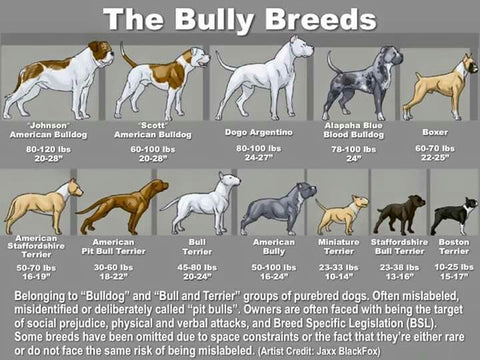Bully Breeds

As we have discussed elsewhere on this site, the terms “pit bull” and “staffy” seem to have been co-opted by people looking for an umbrella term for a certain group of dogs. Unfortunately, both have their limitations: those terms stem from names for specific dog breeds, but have become so widely used they are nearly meaningless. This invites confusion, especially when lawmakers try to use those same terms to restrict dog types and mixes.
When we do need to talk about a category of dogs, more and more advocates are gravitating towards “bully”, “bull breed” or “bully breed”. These terms are being used to describe dogs of unknown parentage, or mixes.
These terms are intentionally loose, because they encapsulate a group of dogs that have branched off from common ancestry: the Molosser breeds. Molosser breeds were used in the foundation stock of many of the breeds we see today. Molosser breeds were bred to serve a purpose and fulfil tasks – because after all, for most of history this was the point of dog breeding and husbandry. **Please note that this group of dogs was around before family pets and were bred for purpose.** These purposes may have included bull baiting, bear baiting, protection, hunting, and combat. They might include bulldog breeds, bull and terrier breeds, and mastiff breeds, ranging from small to very large.
Today, when we talk about bully breeds we are likely referring to breeds or mixes of the following:
Alapaha Blue Blood Bulldog
American Bulldog
American Bully
American Pit Bull Terrier
American Staffordshire Terrier
Bandogge
BoerBoel
Boston Terrier (mini moloss)
Boxer
Bull Mastiff
Bull Terrier
Dogo Argentino
Dogue De Bordeaux
English/British Bulldog
Fila Brasileiro
French Bulldog
Olde English Bulldogge
Presa Canario
Staffordshire Bull Terrier
No terminology will please everyone, but “bully breed” seems to do the best job at being a true umbrella term for dogs that share common ancestry and certain physical characteristics. Keeping in mind that every dog is an individual, if you are pressed to describe a dog type - or to simply describe to a stranger what kind of dog you have - this might be better than the alternatives.
